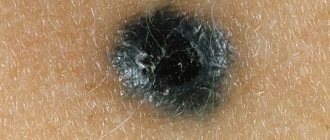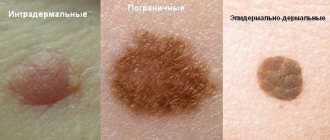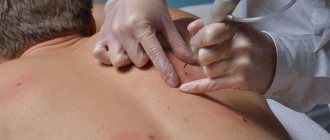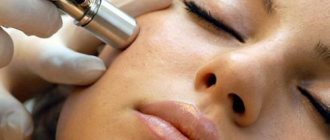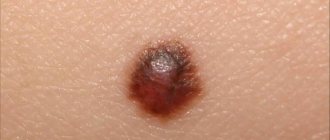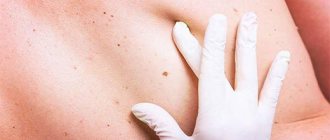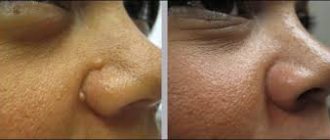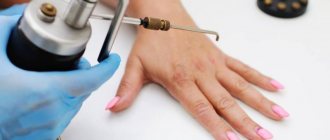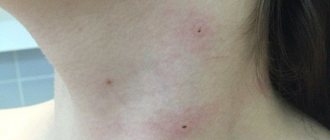.
In order for the wound that formed after the operation to remove a mole to heal faster, it must be treated in a special way and carefully follow all the recommendations given by the surgeon after the corresponding operation.
Sinaflan - ointment for postoperative treatment of moles
Despite the availability of modern methods and the use of best practices in clinics by practicing surgeons, a prerequisite for any operation is the appearance of a small wound. Many patients who have undergone such operations often wonder what is the best way to treat wounds so that they heal faster.
Indications for surgical removal of moles
A mole or nevus is a benign formation on the skin that is round or oval in shape, brown in color, and can protrude above the surface of the skin. People who have moles on their body do not resort to removal procedures. However, under certain circumstances it is advisable to remove nevi. Indications for removal of skin lesions are:
- Increase in size. Large nevi are more easily injured, which poses a threat of bacterial infection.
- Ingrowth into deep layers of skin. A person experiences painful and unpleasant sensations.
- Disintegration into several elements. An alarming sign requiring urgent medical examination.
- The growth is bleeding. A detailed diagnostic examination is carried out, the causes of the symptom are identified, and the mole is excised.
- There is pain, the mole is often damaged.
- Aesthetic discomfort. Moles, especially those located in the facial area, cause psychological uncertainty and embarrassment.
- There are contraindications to the operation (illness, childhood).
Advantages and disadvantages of surgical mole removal
A patient faced with the need for surgical removal of a mole should be aware of the advantages and disadvantages of the procedure. Excision with a scalpel has the following advantages:
- A safe method, takes place in the necessary conditions.
- Local anesthesia relieves pain, the patient does not feel anything.
- After excision, the sample is sent for histological examination. The surgeon will know the nature of the nevus degeneration.
- The laser will not provide this effect.
- The surgical method has no absolute contraindications.
- After resection there is virtually no risk of recurrence.
- Affordable price.
The operation is quick and painless for the patient. The doctor introduces the rules of skin care during the rehabilitation period. In some cases, a postoperative scar remains. Corrected with plastic surgery. Discussed individually with a doctor in each individual case.
Despite the safety and absence of absolute contraindications, the doctor will refuse surgery if the patient has:
- infection;
- herpes on mucous membranes;
- inflammatory process;
- chronic disease in the acute stage;
- The procedure is prohibited for women during pregnancy and lactation.
First, these factors are eliminated, then a date is set for surgical removal of the mole.
Selecting a removal method
So, an oncologist or dermato-oncologist recommended removing the mole, or you decided to get rid of the formation. Consult with a specialist which removal method is best for your situation.
In many cases, histological examination of a removed mole is a mandatory procedure. It is important to evaluate the structure of the nevus tissue and make sure that the formation is truly benign and that nothing threatens your health. In this case, traditional mole removal with a scalpel is one of the most suitable methods. Some modern instruments do not leave a trace of tissue, so it will not be possible to study them in the laboratory.
If a large mole is located on the face or open areas of the body, discuss with a specialist the prospects of using a laser or radio wave removal method. These methods have fewer cosmetic consequences - they do not leave noticeable scars, so it is often advisable to resort to them. Remember that health is more important - if the doctor insists on conventional surgical removal, you should listen, because the prevention and early diagnosis of cancer depends on this.
Which is better: surgery or laser?
The dermatologist or oncologist decides whether the mole will be removed with a laser or scalpel. When the process of malignancy is advanced, the cells degenerate into malignant ones and must be completely excised. If some of the pathological cells subsequently remain, a relapse is possible. The risk of skin cancer is high.
The advantages and disadvantages of laser and surgical excision of moles are highlighted.
| Surgical removal | Laser removal | ||
| Advantages | Flaws | Advantages | Flaws |
| Melanoma is completely removed during surgery | After excision of a birthmark with a scalpel, a scar will remain | Safe, painless way | Inability to conduct histological examination |
| The disease will not recur in the future | Procedure duration 5 minutes | The safety and quality of the intervention are affected by the qualifications of the doctor and the condition of the equipment. Should be considered | |
| It is possible to conduct histological analysis | Burning occurs pointwise, the doctor controls the depth of the beam | ||
| Damaged tissue is removed, the surrounding skin is not injured, and no scars remain | |||
| Recovery takes 1-2 weeks | |||
| Laser excision of moles on the lip, nose, neck, head, back leaves no traces - one of the main advantages | |||
After the procedure, the patient should be aware of the necessary care. After the laser, the skin can be treated with alcohol-free products. After surgery, the sutures are removed on the 5th day.
How does the removal procedure work?
Removing a mole with a surgical scalpel does not require preparation. The patient needs to consult an oncologist. For several days before and after the procedure, it is not recommended to take blood thinning medications or alcoholic beverages.
The operation to remove a mole is carried out on the day the patient applies. On average, the procedure takes 30–40 minutes, which is slightly longer than when performing a similar operation using another method.
The patient lies on the couch. The doctor introduces you to the upcoming procedures. The nevus, together with nearby tissues, is treated with an antiseptic substance. A surgical draper with a hole for access to the nevus is applied to the treated area. A local anesthetic is injected into the mole area. Novocaine is usually used. If the person has not previously been given a specific painkiller, an allergy test is performed before the procedure begins (the wrist is scratched and the drug is sprayed on). When the anesthesia takes effect, the doctor begins the operation.
An incision is made with a scalpel along the perimeter of the tumor. The number of incisions depends on the size of the nevus and its depth. The larger it is, the more manipulations will be required for excision. To prevent recurrence of the formation, the doctor may cut out a few millimeters of healthy skin. Once the growth is removed, a gauze bandage is applied. The surgeon is preparing to stitch the wound. Sometimes, if the formation has a pronounced pedicle, you can do without sutures. The wound is cauterized, treated with an antibiotic, and a bandage is applied. If the mole has a large diameter and the elevation above the skin is minimal, the wound will have to be sutured. To be determined by a dermatologist, a regular thread or one that is absorbable is selected. The sutured wound is treated with an antiseptic solution and a sterile bandage is applied.
The excised tissue is sent to the laboratory for histological examination. During the analysis, it will be determined whether malignant cells are present in the tissues of the tumor and at what stage the disease is. Based on the information received, a further course of action is selected.
If a person is worried about the pain of the surgical excision method, all fears are in vain. The anesthesia used for the procedure makes the treatment site insensitive, which guarantees complete painlessness for the period of all necessary manipulations.
No special treatment is prescribed after the procedure. The wound should be properly cared for and protected from direct exposure to sunlight in the summer. It is forbidden to pick off the crust that has formed on the wound.
If during the rehabilitation period the temperature rises, the person feels a deterioration in his condition and general weakness. You should consult a doctor.
Hazards
The main factor in the formation of nevus is genetics, that is, hereditary predisposition. There are many cases where newborn babies have the same moles as one of the parents. A small organism also inherits the type of education.
The second factor that causes the appearance of age spots is regular exposure to ultraviolet radiation. Surely, recently, many have heard recommendations from doctors that it is better to take sunbathing after 17:00 or before 11:00 am. Increased solar activity, natural disasters and human activity on the planet have led to a thinning of the protective layer of the atmosphere, so dangerous ultraviolet radiation freely reaches the surface of the earth. It is extremely dangerous even for the healthiest skin.
When tanning under the sun or in a solarium, the level of melanin in the skin increases, a dangerous hormone that causes cancer. Therefore, it is necessary to use protective creams and lotions, wear clothes that cover your arms, shoulders, and chest. You should not ignore the advice of oncologists about staying in the shade on a hot summer day at the beach. It is better to be left without a temporary bronze skin tone than to face serious health problems in the future and the not always pleasant consequences of surgically removing a mole.
The massive appearance of nevi is characteristic of puberty, menopause and hormonal therapy. Problems with the adrenal glands and endocrine diseases can also lead to an imbalance in the body.
Doctors consider the following categories to be at risk:
- workers whose activities involve increased ultraviolet radiation;
- persons who often stay in equatorial regions under the scorching sun;
- employees of chemical industries and industry;
- patients taking hormones for a long time;
- people whose relatives have been diagnosed with skin cancer.
In some cases, doctors diagnose the appearance of benign and gradually degenerating formations after injuries, scratches, bites, and cuts. The ongoing inflammatory process affects several layers of skin at once. This leads to the activation of biologically active environments that stimulate cell growth and development.
Features of the postoperative period
The postoperative rehabilitation period begins immediately after the removal procedure is completed.
As soon as the wound is sutured and a sterile bandage is applied, in the absence of complications, the patient returns to his usual lifestyle. A person needs to remember the precautions that are necessary to prevent the development of undesirable postoperative consequences.
It takes 7–14 days for the wound to heal. The speed of healing depends on the depth of damage and the characteristics of the body. Gradually, the wound becomes covered with a crust, under which new healthy skin grows.
The doctor will recommend medications to the patient for treatment. This is a special disinfectant solution, hydrogen peroxide, furatsilin or another product. When using non-absorbable threads, treatment of the wound before removing the sutures should be carried out under the supervision of the attending physician. This is true if the wound is difficult to access - on the back or head.
For a successful skin restoration process, a person must follow a number of important rules:
- avoid exposure of the wound to sunlight;
- prevent the damaged area from getting wet;
- do not scratch the wound;
- carry out regular treatment with antiseptic drugs;
- observe hygiene standards when changing the dressing;
- refuse to visit the bathhouse, swimming pool, sauna, solarium;
- Do not peel off the resulting crust.
The norm is considered to be a slight increase in body temperature in the first week after the removal procedure. If the temperature persists longer or exceeds 38 degrees, there is a possibility of a bacterial infection, which is a reason to urgently consult a doctor.
Surgical excision of a mole allows you to protect yourself from a possible relapse and complications in the form of malignant nevus. It happens painlessly. When the anesthesia wears off, the person will feel discomfort, which will gradually subside.
The type of intervention chosen affects the duration of the rehabilitation period. The risk of relapse increases significantly when using a laser. Excision does not completely guarantee that the problem will not recur after some time.
Excision with a scalpel is the most suitable option. The affected cells and part of the healthy tissue are removed. Eliminates the risk of the remaining cells degenerating into a malignant formation.
When removing a nevus from a child, the scheme remains the same. The type of intervention is chosen exclusively by the attending physician.
Recovery after surgery and suture care
Recommendations for wound care:
- the area where the procedure was performed must remain dry;
- the wound must be periodically treated with antiseptics and the bandage changed;
- if a crust forms, do not apply mechanical force (it should fall off naturally);
- protect the future scar from exposure to sunlight;
- After a week, remove the stitches.
After the crust dies, young skin remains underneath.
It is recommended to protect the place from sun exposure for 60-90 days. On average, it will take 3-4 months for complete healing.

